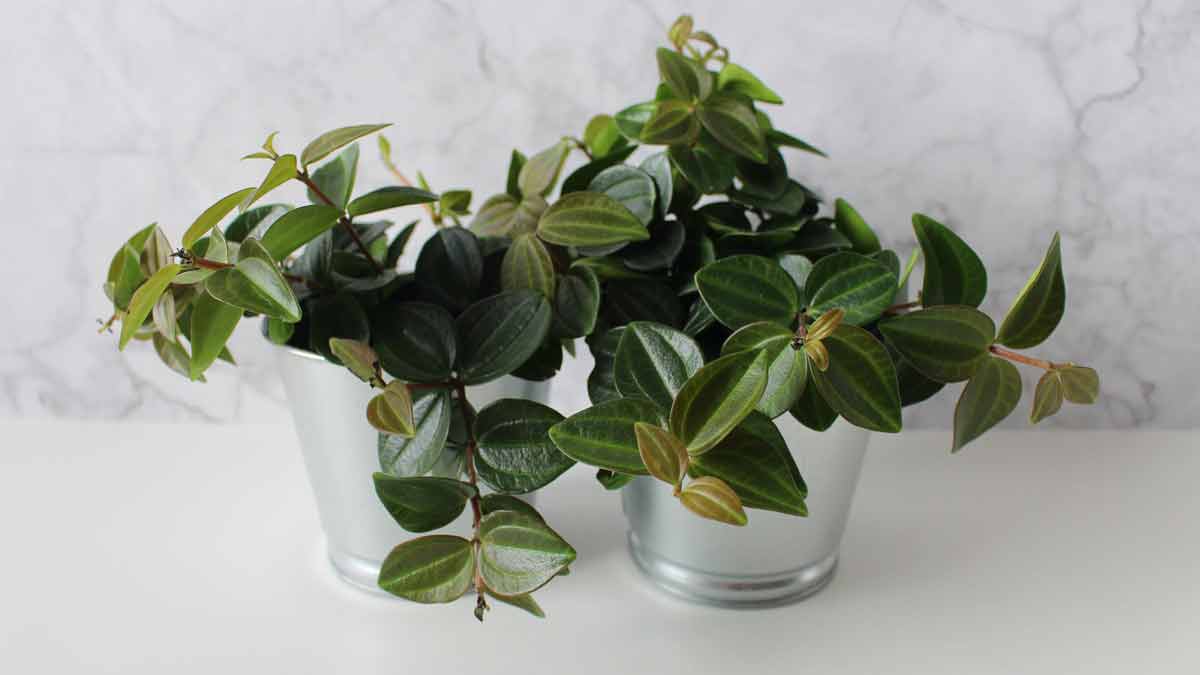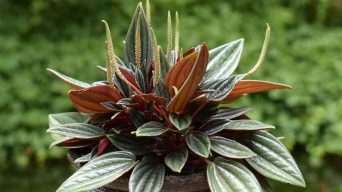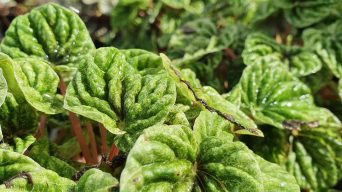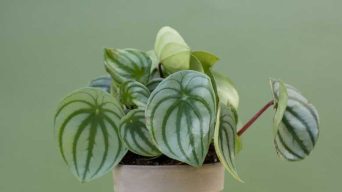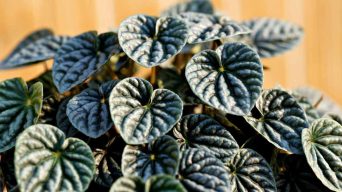Key Takeaways
- Overwatering and poor drainage are the most common causes of yellowing leaves in Peperomia plants.
- Other factors, such as lack of water, excessive sunlight exposure, diseases, pest infestation, nutrient deficiency, and natural aging, can also lead to yellow leaves.
- To treat yellowing Peperomia leaves effectively, adjust watering frequency based on soil moisture levels, improve drainage by using well-draining potting mix or adding perlite or sand, and move the plant to a location with suitable light conditions while checking for signs of disease or pests.
Peperomia plants are popular houseplants for their attractive foliage, versatility, and easy care.
However, even the most skilled plant owners can experience yellowing leaves in their beloved Peperomia.
Yellow leaves could indicate numerous issues, such as overwatering, lack of proper drainage, diseases, or insufficient light exposure.
In this blog post, we’ll delve into the common causes of yellow Peperomia leaves and how to treat them so you can enjoy a vibrant and healthy plant more effectively.
Common Causes Of Peperomia Leaves Turning Yellow
Several factors, including overwatering, poor drainage, inadequate watering, excessive exposure to sunlight, diseases, pest infestation, nutrient deficiency, and natural aging, can cause the yellowing of Peperomia leaves.
Overwatering
Overwatering is the most common culprit behind yellowing leaves in Peperomia plants, as excessive moisture can cause roots to suffocate and even rot.
Root damage hinders the plant’s ability to absorb vital nutrients, leading to a weakened state and discolored foliage.
To avoid overwatering your Peperomia plant, use a well-draining potting mix with ample drainage holes at the bottom of its container.
Wait for the soil surface to dry before watering again; this ensures that your beloved tropical houseplant gets adequate oxygen while maintaining essential hydration levels.
Poor Drainage
Poor drainage is a common culprit behind yellowing Peperomia leaves.
When the potting mix has insufficient drainage capabilities, excess water cannot escape and tends to accumulate in the soil, leading to overly saturated conditions.
This effectively drowns your plant by preventing oxygen from reaching its roots.
To address poor drainage, consider repotting your Peperomia into a well-draining potting mix that usually contains peat moss or perlite for improved moisture-retention control.
Additionally, ensure the container you use provides adequate holes at the bottom for proper water release during watering sessions.
This will help prevent standing water around your plant’s roots and maintain good air circulation.
Lack Of Water
Despite Peperomias being relatively drought-tolerant, consistently dry soil can lead to the yellowing of leaves.
A lack of water restricts the plant’s ability to transport nutrients and oxygen through its root system, leading to the deterioration of foliage health.
Plant owners must monitor their watering habits and maintain a consistent schedule based on their specific Peperomia variety to prevent this issue.
For instance, waiting until the top 50-75% of potting soil feels dry before watering ensures the roots remain hydrated while avoiding excessive moisture.
Furthermore, adding humidity trays or running a humidifier nearby promotes balanced conditions for optimal growth and prevents drying out too quickly between waterings.
Excessive Sunlight
Excessive sunlight can be one of the common causes of Peperomia leaves turning yellow.
While these plants need bright indirect light to thrive, too much direct sunlight can burn and scorch the leaves, leading to yellowing.
If you notice your Peperomia’s leaves becoming discolored or dry in areas that receive a lot of sun exposure, it may be time to move the plant to a spot with the right amount of light.
Diseases
Diseases can also cause Peperomia leaves to turn yellow.
Common leaf spot and fungi are some of the most prevalent diseases that affect Peperomia plants.
Leaf spots often manifest as brown or black circular patches on the foliage, while fungal infections make the leaves appear mushy and discolored.
In severe cases, affected leaves may drop from the plant entirely.
These diseases can spread quickly if left uncontrolled and even damage the roots of new plants growing nearby.
Pest Infestation
A pest infestation can commonly cause yellowing leaves in Peperomia plants.
Mites, aphids, and whiteflies are potential pests that can be present in the plant’s foliage.
These insects feed on the sap from the plant’s leaves, causing discoloration and weakening of the foliage.
Insecticidal soap or neem oil can effectively control these pests.
It is also essential to keep a close eye on your peperomia plant for signs of infestation to catch it early before significant damage occurs.
Nutrient Deficiency
Peperomia plants require a balanced and steady supply of essential nutrients to thrive.
Nutrient deficiency is among the most common reasons for yellowing leaves in peperomia plants.
To address nutrient deficiencies, it is important to use the right type of fertilizer and apply it correctly.
An imbalanced concentration of fertilizer can do more harm than good by causing root burn or leaf damage.
Additionally, adding natural fertilizers like crushed eggshells to your potting mix can provide much-needed calcium that helps with cellular function and healthy leaf growth.
Natural Aging
As with any living thing, plants undergo a natural aging process.
As Peperomia plants mature, their older leaves eventually die and turn yellow before falling off.
However, notice that the yellowing affects mostly new or young leaves rather than the older ones for an extended period.
It may be an indication of nutrient deficiency or other underlying issues.
It’s important to regularly inspect your Peperomia plant for signs of distress as they grow so you can take appropriate measures to address any problems before they become too severe.
Identifying And Diagnosing The Problem
If you notice your Peperomia leaves turning yellow, it’s important to examine the leaves, soil, and growing conditions to determine the cause.
Inspect The Leaves
To correctly identify and diagnose the issue causing your Peperomia leaves to turn yellow, it’s essential to inspect them closely.
Look for discoloration, spots, or abnormalities on both sides of the leaf.
If the yellowing is along the edges or margins of the leaf, this could indicate a nutrient deficiency such as calcium.
Additionally, examine how many leaves are affected and their placement on the plant – if it’s only a few older leaves towards the bottom that are turning yellow and falling off naturally, there might not be anything wrong with your Peperomia plant!
Conversely, suppose you notice new growth appears stunted or distorted compared to healthy foliage further up the stem.
This can signify pest infestation by mites or aphids that feed directly on young tissue before moving onto mature areas.
Check The Soil
One of the most important steps in identifying why your peperomia leaves turn yellow is to check the soil moisture level.
Consistently too wet or dry soil can cause stress and damage your plant, resulting in yellowing leaves.
To easily check if your soil needs water, stick a finger about 1-2 inches deep into the soil.
If it feels dry, it’s time to water your peperomia plant.
On the other hand, if it feels moist, avoid watering until the top inch of soil has dried out.
To further diagnose any issues with your peperomia’s soil health and composition, you can conduct a pH test using a simple testing kit available at most gardening stores.
A slightly acidic soil pH between 5.0 to 6.0 will help ensure optimal nutrient absorption by roots while avoiding toxic buildups caused by high concentrations of salts in hard tap water or fertilizers applied excessively during the growing season.
Examine The Growing Conditions
To diagnose the problem of yellowing leaves in your Peperomia plant, it’s essential to examine its growing conditions.
Check the room temperature and humidity levels, as Peperomia plants require a warm and humid environment for optimal growth.
If it’s too cold or dry, this could be causing your plant stress.
Look at the soil quality as well – good drainage is crucial for healthy Peperomia plants, so ensure the pot has proper drainage holes and that water does not accumulate on top of the soil after watering.
Additionally, peat moss can improve moisture retention without compromising drainage, while perlite helps with better air circulation in the root space.
Effective Treatment Methods
If you want to treat yellowing Peperomia leaves, you should adjust the watering frequency, enhance drainage, relocate to better light conditions if required, and manage pests or diseases as necessary.
Adjust Watering Frequency
One effective treatment method for preventing remaining leaves from yellowing and turning brown is to adjust the watering frequency.
Follow these easy steps to ensure proper watering of your Peperomia plant:
- Rather than watering on a set schedule, always check the top two inches of soil and water only when it has dried out.
- When you water your Peperomia plant, always soak the soil thoroughly. Water until it begins to drain out of the bottom of the pot.
- Always use room temperature water; cold water can shock the roots and cause damage.
- Try to use distilled or filtered water rather than tap water. This will help avoid any buildup of minerals like fluoride or salts that can harm your plant over time.
- During the growing season, which typically runs from spring through summer, you’ll need to water your Peperomia more frequently than in the fall and winter months.
- Always be aware that too much moisture is just as harmful as not enough. Signs of overwatering include rotting stalks, wilting or yellowing leaves, a heavy pot, and waterlogged soil.
By adjusting your watering frequency and following these simple steps, you’ll be well on your way to keeping your Peperomia plant healthy and thriving!
Improve Drainage
To prevent yellowing leaves caused by poor drainage, improving the conditions of your plant’s soil is important.
Here are some ways you can do this:
- Use a well-draining potting mix: Peperomia plants require light and airy soil to promote good drainage. Avoid using heavy soils or regular garden soil.
- Add perlite or sand: If your potting mix lacks drainage, add perlite or sand to improve its drainage capacity.
- Choose a pot with drainage holes: Ensure that the container where your Peperomia plant is housed has ample drainage holes.
- Elevate your pot: Placing your plant on feet or small bricks can help create space for excess water to drain more efficiently out of the pot.
- Water deeply but less frequently: Watering too often can lead to waterlogged soil and poor root health. Instead, allow the top inch of soil to dry out before watering thoroughly.
Move To A Better Location
If you notice your Peperomia plant’s leaves turning yellow, move it to a more suitable location.
Here are some tips on how to do it:
- Look for a spot with indirect sunlight: Peperomia plants prefer bright indirect light, so look for a place that gets plenty of natural light but is not directly exposed to the sun.
- Keep away from drafts: These plants do not like rapid temperature changes, so keep them away from open windows or air conditioning vents.
- Consider humidity levels: Peperomias enjoy humid conditions, so consider placing them in a room with higher humidity levels or using a humidifier.
- Check for proper ventilation: Good air circulation is important for the plant’s health, so avoid placing it in a closed-off space without adequate ventilation.
Moving your Peperomia plant to a better location can help prevent yellow leaves caused by excess sunlight or low humidity levels.
Treat Diseases
If you notice any signs of disease on your Peperomia plant, it is important to act quickly to prevent it from spreading.
Here are some effective treatment methods:
- Use a fungicide: If your Peperomia has leaf spot disease, use a fungicide to keep it under control.
- Remove affected leaves: If you notice any yellow or brown spots on the leaves caused by diseases such as root rot or fungus, remove them immediately.
- Improve air circulation: Some fungal diseases can be prevented by improving air circulation around the plant.
- Neem oil solution: You can use neem oil to help control pests and fungal infections in your Peperomia plant.
- Maintain proper watering practices: Overwatering can lead to root rot and other fungal diseases. Maintaining an appropriate watering practice ensures the soil is moist but not soggy.
Control Pests
One of the causes of yellowing leaves on your Peperomia plant can be pest infestations.
Here are some tips to help control pests and prevent future problems:
- Regularly inspect your plant for signs of pests like spider mites, mealybugs, and scale insects.
- If you notice an infestation, isolate the affected plant to prevent other plants from becoming infected.
- You can try natural remedies like neem oil or insecticidal soap to manage pest problems and prevent future occurrences.
- Keep your plant clean by wiping the leaves with a damp cloth to remove any dust or debris that could harbor pests.
- To keep fungus gnats away, let the soil dry out slightly between waterings and use fresh potting soil when repotting.
- If all else fails, a systemic insecticide may be necessary to eliminate a persistent pest problem on your Peperomia plant.
Add Nutrients
Adding nutrients to the soil is an effective solution to fix yellowing Peperomia leaves.
Here are some ways to do it:
- Use a balanced fertilizer: Choose a high-quality fertilizer formulated explicitly for houseplants and dilute it according to instructions before applying it to the soil.
- Apply natural fertilizers: You can use natural fertilizers like crushed eggshells, coffee grounds, or banana peels, which are good sources of calcium and potassium.
- Use slow-release granules: Slow-release fertilizers come in small granules that release nutrients into the soil over time, providing a steady supply of nutrients to your Peperomia plant.
- Use liquid fertilizers: Liquid fertilizers are quickly absorbed by the roots and can immediately boost nutrients to your plant.
Remember that overfertilizing can harm your Peperomia plant, so follow the instructions on the package carefully and don’t exceed recommended doses.
Adding nutrients can help prevent nutrient deficiencies that cause yellowing leaves and promote healthy growth in your Peperomia plants.
Prune
Pruning is an effective way to treat yellowing Peperomia leaves.
Follow these steps for proper pruning:
- Use clean and sterilized pruning shears or scissors.
- Identify any yellowed, browned, or dying leaves.
- Cut the affected leaves at the base of the stem, close to the main plant body.
- Make sure to remove any dead or dying stems as well.
- Dispose of the pruned foliage properly.
Pruning helps improve the overall health of your Peperomia plant by removing any diseased or damaged parts that can potentially spread to other parts of the plant.
It also encourages new growth and promotes better nutrient absorption in healthy leaves.
Remember not to over-prune your plant, as this may lead to stress and damage.
Only prune when necessary and avoid cutting more than 30% of its foliage at once.
Prevention And Maintenance Tips
To keep your Peperomia healthy and prevent the yellowing of its leaves, it’s important to monitor its soil moisture and ensure adequate drainage while watering.
Regular fertilization, pest control, refreshing the soil, and monitoring its light exposure is essential to maintaining a healthy plant.
Water Properly
Proper watering is crucial in caring for Peperomia plants and preventing yellowing leaves.
Here are some tips on how to water your plant properly:
- Water infrequently: Peperomia plants should be watered moderately only when the top inch of the soil is dry. Overwatering can lead to root rot and yellowing leaves.
- Use room temperature water: Avoid cold or hot tap water, as extreme temperatures can shock the roots and damage the plant.
- Water from the bottom: Fill a tray with water and place the pot in it, allowing the plant to soak up water from the bottom. This ensures that the roots receive adequate moisture without getting oversaturated.
- Don’t let it sit in standing water: After watering, empty any excess water from the tray to prevent root rot.
- Adjust the watering frequency based on growing conditions: Plant growth, humidity levels, and temperature can all affect how often your Peperomia plant needs watering. Monitor your plant regularly and adjust accordingly.
Provide Adequate Drainage
To prevent yellowing leaves on your peperomia plant, it is crucial to provide adequate drainage.
Poor drainage is one of the leading causes of root rot and other fungal diseases that can damage the plant.
Here are some tips on how to provide proper drainage for your peperomia:
- Choose a well-draining potting mix that contains perlite or vermiculite.
- Ensure your pot has a drainage hole at the bottom to allow excess water to escape.
- Use a saucer or tray beneath the pot to catch any runoff water.
- Avoid using saucers or trays that do not have drainage holes, as they can keep excess water close to the roots and lead to root rot.
- After watering, promptly empty any excess water from the saucer or tray.
Providing adequate drainage for your peperomia plant can ensure healthy growth and prevent yellowing leaves caused by overwatering and poor soil moisture levels.
Monitor your plants’ soil moisture levels regularly to avoid underwatering or overwatering them unintentionally.
Monitor Light Exposure
Proper lighting is essential for the health of Peperomia plants.
Here are some tips to help you monitor light exposure and prevent yellowing leaves:
- Place your Peperomia plant in a bright, indirect light source. Direct sunlight can scorch the leaves, while too little light can cause yellowing.
- Rotate your plant every few weeks to ensure all sides receive adequate light.
- Check for any changes in lighting conditions that may affect your plant, such as moving it to a different room or changing window coverings.
- Use a light meter to measure light intensity in different locations around your home. This will help you identify the best spot for your Peperomia plant.
- If your plant leaves turn yellow despite proper watering and soil management, adjust its lighting conditions accordingly.
By following these guidelines, you can ensure that your Peperomia plant receives the optimal amount of light and prevent yellowing leaves caused by inadequate light exposure.
Keep Pests At Bay
To keep pests from attacking your peperomia plant and causing its leaves to turn yellow, here are some tips to follow:
- Always quarantine new plants before introducing them to your current collection.
- Inspect the plants regularly for signs of infestation, such as tiny white dots or webbing on the leaves and stems.
- Use a gentle, natural insecticidal soap or neem oil spray to kill visible pests.
- Clean the area around your plants regularly to prevent spider mites and other pests from breeding.
- Increase humidity levels by placing a tray of water near the plant or using a humidifier, as dry air can attract spider mites and other pests that cause the yellowing of leaves.
- Avoid over-fertilizing your peperomia plant, as this can increase pest activity and cause yellowing of foliage due to nutrient burn.
By following these tips, you can effectively keep pests at bay and prevent any yellowing of your peperomia plant leaves caused by pest infestations.
Fertilize Regularly
Regularly fertilizing plants is one crucial step toward treating and preventing yellowing leaves in Peperomia plants.
Here’s how you can do it:
- Use a well-balanced fertilizer: Choose a fertilizer with equal or higher concentrations of nitrogen, phosphorus, and potassium (N-P-K), such as 10-10-10 or 20-20-20.
- Dilute the fertilizer: Mix the fertilizer with water as instructed on the label, usually one tablespoon per gallon of water.
- Apply the fertilizer: Water the plant thoroughly before diluting the fertilizer to avoid root burn. Pour it slowly over the soil, making sure not to get any on the leaves.
- Fertilize during active growth: Peperomias grows actively during spring and summer, so they fertilize monthly during this period and avoid fertilizing during winter when they go dormant.
- Use natural fertilizers: Instead of synthetic fertilizers, you can use natural sources like crushed eggshells, banana peels, or bone meal that release nutrients slowly over time.
By fertilizing your Peperomia plant regularly and appropriately, you can prevent nutrient deficiencies that cause yellowing leaves.
Refresh Soil
If you suspect that the soil in your Peperomia pot has become depleted of nutrients or is no longer suitable for growing healthy plants, it may be time to refresh the soil.
Here are some steps to follow:
- Choose a potting mix or soil for indoor plants containing peat moss, perlite, vermiculite, coconut coir, or other organic materials to promote good drainage and moisture retention.
- Remove your Peperomia plant from its current pot and gently shake off any excess soil from the roots.
- Use a clean pair of scissors or pruning shears to trim away any dead or damaged roots before repotting your plant.
- Add a layer of fresh potting mix to the bottom of your new pot, then position your Peperomia on top, ensuring the root ball is centered and level.
- Fill around the sides with more potting mix until the plant is secure and stable.
- Tamp down the soil with your fingers or a small gardening tool to eliminate air pockets and ensure good contact between the roots and the soil.
- Water thoroughly after repotting and avoid fertilizing for at least 2-3 weeks until your plant has settled into its new environment.
Refreshing your Peperomia’s soil every year or so can help maintain healthy growth and prevent issues like nutrient deficiency or root rot caused by compacted or depleted soil.
Final Thoughts
If you notice your Peperomia leaves turning yellow, don’t panic!
While it can be alarming, this issue is common and treatable with the proper steps.
Whether it’s overwatering or a nutrient deficiency, identifying the cause and taking corrective action will help bring your plant back to its healthy state.
By adjusting watering frequency, improving drainage, controlling pests, and adding nutrients as needed, you’ll be well on your way to preventing further leaf yellowing.
Implement preventative measures like monitoring light exposure and regularly fertilizing your plant.

